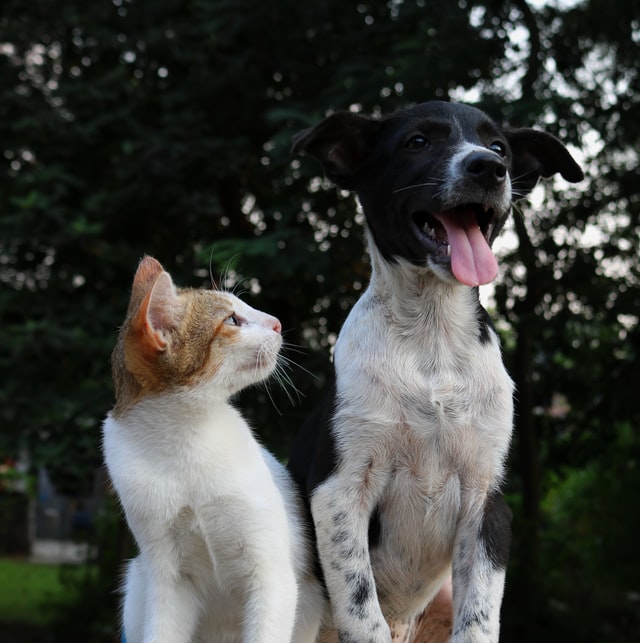
Wellness Exams: What’s All the Fuss About?
Does it seem like we’re always asking you to bring your pet in for a wellness visit? As much as we love seeing your adorable dogs and cats—and we do!—that’s not the only reason we want them to visit us regularly.
Wellness exams and preventive care play an essential role in keeping pets as healthy as possible throughout their lives. At Mt. Shasta Animal Hospital, we typically recommend wellness exams once a year for healthy adult cats and dogs and more frequently for young pets, senior pets, and those with chronic medical conditions. We also recommend bringing in any newly adopted pet for a wellness exam.
Curious to learn more about why we ask you to bring your pet in for regular veterinary visits? Keep reading!
We’ve got a lot to cover, so we’ve broken this blog article into pet life stages. Feel free to skip ahead to the life stage your pet is in now.
Puppies and Kittens
When dogs and cats are young, we want to see them frequently to make sure they’re adequately protected by vaccines, including distemper, hepatitis, parvovirus, parainfluenza, and leptospirosis for puppies and feline viral rhinotracheitis, calicivirus, panleukopenia (feline distemper), and feline leukemia virus (FeLV) for kittens. Depending on your pet’s lifestyle and risk factors, we may also recommend additional vaccines.
Starting when pets are 6 to 8 weeks of age, the initial series of vaccinations is given every 2 to 4 weeks until about 16 to 20 weeks of age; a rabies vaccine will also be administered once your pet is old enough. After that, most vaccines require boosters every year or every 3 years to keep your pet protected.
We also want to see young pets several times over that first crucial year to make sure their heart and other organs are healthy, they’re gaining weight and body mass as expected, and their teeth and bones are developing normally.
This is also when your Mt. Shasta veterinarian will deworm your pet to get rid of any intestinal parasites and recommend parasite control, such as flea/tick control and heartworm disease preventives.
When it comes to spaying or neutering pets who will not be bred, we generally follow American Kennel Club (AKC) recommendations, which suggest waiting to spay or neuter until pets have reached sexual maturity. So what does this mean for our young patients? We recommend spaying or neutering around:
- 1 year for most dogs and cats
- 2 years for large- and giant-breed dogs
Waiting until then may help decrease the risk of certain cancers and joint problems like hip dysplasia and cranial cruciate ligament injury.
Spaying/neutering has many benefits as well, such as helping to reduce some undesirable behaviors and protecting female dogs and cats against a potentially life-threatening type of uterine infection called pyometra.
Adult Cats and Dogs
As pets move into their adult years, they should visit us at least once a year for a regular wellness exam. During these visits, we’ll:
- Perform a thorough physical exam of your pet
- Give your pet needed vaccine boosters to help provide continued protection against serious, highly contagious, and potentially deadly diseases
- Recommend additional vaccines to help protect against diseases that your individual pet may be at risk for because of lifestyle, risk of exposure, and other factors
- Check blood work for heartworm disease, tick-borne diseases, and any other hidden diseases or health conditions
- Make sure your pet remains free of ticks and fleas
- Check for intestinal parasites (that’s why we ask you to bring your pet’s stool sample!)
- Examine your pet’s mouth and teeth and recommend any dental care that’s needed
- Perform a nutritional assessment to help make sure your pet is getting the right nutrition for their breed, life stage, health, and lifestyle
Even indoor-only cats need vaccinations to help keep them protected against hardy, potentially deadly diseases that can find their way inside on clothing, shoes, and other inanimate objects. Vaccines also protect cats in case they need to be boarded or in the (hopefully unlikely) event that they manage to slip outside.
Senior Pets
Once pets begin moving into their senior years (between 6 and 8 years of age for most pets, but sometimes a bit younger for larger dogs and a little older for healthy cats), we prefer to see them at least twice a year. Remember that pets age far faster than we do—unfortunately, this is why we have less time with them than we’d like!
During this life stage, senior wellness exams continue to help us detect any potential diseases or conditions, like osteoarthritis, cancer, dental (periodontal) disease, thyroid issues, and heart, kidney, and liver disease, that may become more common as pets age. Many pets don’t tend to show signs of disease, especially in the early stages.
Pets With Chronic Conditions
Dogs and cats who have a chronic disease or are on regular medications also tend to benefit from more frequent veterinary visits. These visits let us check blood work and monitor your pet’s condition or disease, allowing your Mt. Shasta veterinarian to make medication or other adjustments as needed.
What’s the Deal With Diagnostics?
Regular testing of pets, including blood work, urinalysis, and fecal screening, helps us identify any hidden diseases or health conditions. We wish our eyes were crystal balls, but that’s just not the case! That’s why we turn to these helpful diagnostic tests to give us insights into your pet’s health.
The earlier we can catch any changes, the better. Early diagnosis can provide us with more options for treatment.
More frequent veterinary exams and regular preventive care may even give you more quality time with your pet.
What Do You Gain From Your Pet’s Wellness Exam?
Besides playing a crucial role in helping to keep your pet healthy throughout life, regular wellness exams give you the opportunity to:
- Ask us about any questions or concerns you might have
- Bring up anything you’ve noticed that seems different with your pet, like a behavior that’s new or a lump or bump you hadn’t noticed before
In addition, screening tests can not only give us an early start on a pet’s treatment, but if they come back negative, they can give you peace of mind—just what your (pet’s) doctor ordered.
Keep a list of questions you want to ask, and if possible, also bring photos or videos of any behavior or symptom you’re concerned about.
What’s the Scoop on Pet Poop?
When you come in for your pet’s wellness exam, please bring a fresh fecal sample from your dog or cat. The sample should ideally be obtained as close to your pet’s appointment as possible. However, we understand that sometimes your pet’s bathroom schedule may not conveniently line up with their exam time.
So just how fresh are we talking? The sample:
- Should ideally be obtained within the past few hours (but not more than a day old)
- Should not be left in the sun or frozen
- Can be scooped using a regular poop bag or clean plastic baggie
- Can be refrigerated if you know it’s going to be a few hours before you arrive (you can place the poop bag inside a disposable food container or an old, rinsed yogurt container to add another layer of odor protection)
In addition, if you happen to grab a bit of litter or grass along with the poop, that’s fine. We don’t need a lot of it either; a couple “pieces” would be perfect.
Let’s Be Proactive Together!
If you notice that your pet is behaving differently or if your dog or cat just seems off, contact us right away. When possible, we want to catch anything that isn’t normal as soon as possible.
Call us at 530-926-5266 to schedule your pet’s wellness exam, or make an appointment today.


